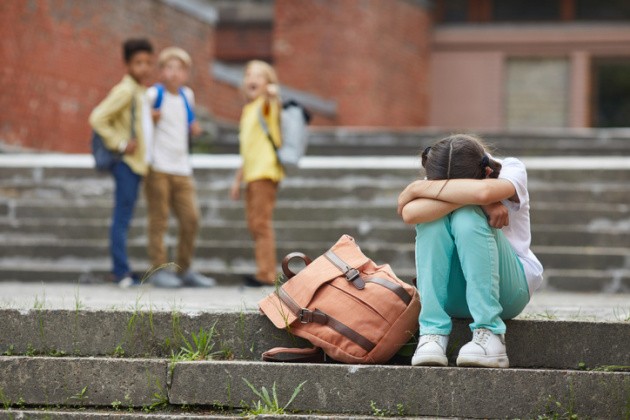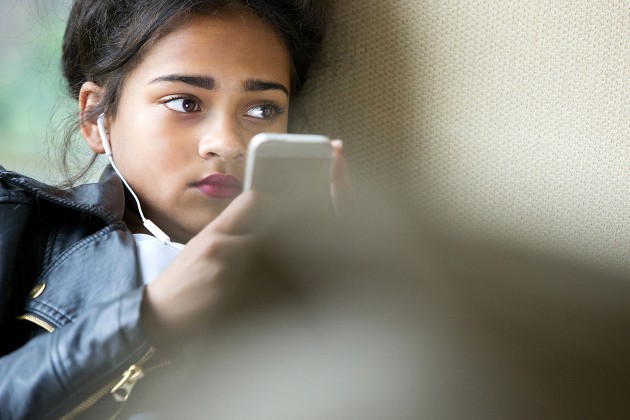Dear Highlights Podcast: How to Be The Helper That Today’s Children Need

Hanh Bui fled her homeland of Vietnam as a child. She remembers the challenges of arriving in a new country, with new customs, language and expectations. Even more, she remembers the people, and especially the children, who welcomed her, and who gave her the connectedness she needed to make a new home. Today she’s a teacher, children’s author and advocate.
In this Dear Highlights episode, Hanh invites us to think about how we cannot just look for the helpers, but be the helpers, who make all children belong. She talks with Christine French Cully, Highlights Editor-in-Chief, about her remarkable journey.
Christine shares that kids write to Highlights about how they struggle when they’re singled out or mocked for being perceived as different, like Kiera who says:
People make fun of me because I’m Chinese. They squint their eyes to mock me and always say, ‘why are you closing your eyes in pictures.’ People say I’m ugly. What do I do?
Hanh hopes her story will help kids understand different perspectives and how to be helpers, like this Highlights reader who says:
Dear Highlights, I’m an immigrant. I decided to do a report on immigrants, and I discovered an organization called ICE. I realized how badly immigrants were being treated in some places, and I wanted to know how I could help. Got any ideas?
Christine welcomes Hanh and asks her to share how she and her family came to the United States.
Hanh explains that most of her family left Vietnam during the fall of Saigon in April 1975. They left suddenly and boarded a ship that was incredibly overloaded with refugees. They knew the ship wouldn’t make the journey with everyone on board—the ship was having trouble sailing and there weren’t enough supplies for everyone. However, Hanh’s family knew that American soldiers were on ships nearby headed back to the United States and would help rescue them. After 9 days at sea, they were rescued by the U.S. Navy. This is the first time, she says, she met her American helpers. A sailor carried her brother and her to safety aboard the Navy ship.
By the time they were rescued, they were hungry and needed medical attention. Military personnel and volunteers helped make sure they were fed and tended to. She was 8 at the time, and the ship took them safely to the first of two refugee camps.
Christine asks what it was like to live in refugee camps.
Hanh explains that she lived in two camps—one in Guam and one in Pennsylvania. The camp in Guam was known as “tent city” because there were so many tents to help house refugees. After they were processed, they moved to the second refugee camp in Fort Indiantown Gap in Pennsylvania. She remembers her grandparents being scared during this transition because of the uncertainty around what would happen and where they would end up. However, for her and her siblings, after they got over their fears of being around so many soldiers and big trucks, it felt like an adventure. Hanh’s fears were allayed by her grandparents explaining that the soldiers were helpers in their journey to the United States.
She remembers fondly the mess hall where she and her siblings ate American food, which they loved. Hanh notes that there were schools at the refugee camps, which helped create a feeling of normalcy.
There was a teacher at one of the camps who had an enormous influence on Hanh. Christine asks her to talk about how this teacher supported and inspired her.
Hanh recalls Ms. Mary Lou. She was her first teacher in the camps, and Hanh gravitated toward her because her voice was soft and gentle. She had a warm smile that made Hanh feel comforted. Even though Hanh couldn’t understand what Ms. Mary Lou was saying, she explains, she knew she was there to help. It felt normal to be in school. Hanh loved the way Ms. Mary Lou spoke English, and she aspired to speak English like her one day.
While at the camps, Hanh was surrounded by family and peers and other people she could trust, like her teacher and the soldiers. But after they left the camps, Christine asks what life was like then.
It was scary leaving the camps, Hanh explains. She shares they were surrounded by Vietnamese people who were all going through the same experience. She recounts, “There were so many volunteers and helpers, and there was a routine set up, so we felt like we knew what to expect…I felt comfortable.”
Leaving the camps meant leaving that feeling of security behind.
Hanh remembers their first home after the refugee camps. It was a row house that shared a front walkway with the house next door. The person who lived in that house was harsh with Hanh’s family. He demanded they not walk on his side of the stairs or play on the sidewalk in front of his house. Her grandparents eventually won him over with kindness, Hanh says. Her grandfather would shovel snow and rake leaves for him, and one day Hanh’s grandfather and uncles helped the man when he was having car troubles. After that, Hanh notes, the man was softer toward them.
There are so many ways that we as helpers can help people that are coming now, like dropping off donations, packing up food, …and just by showing kids that they can have a hand in it.
Christine empathizes that it must have been hard to have such a cold welcome in their new home. Hanh acknowledges it was, but the welcome they received from the church that sponsored them and its congregation was incredibly warm and helped them feel included. Hanh recalls seeing the people from the church standing on the big front porch, waiting to welcome them. She remembers smelling the delicious food they had prepared. It gave her a very warm and welcoming feeling.
Even though many helpers ensured Hanh and her family members were settled in America, Christine notes that there were hardships around being different and making this new place their home. She asks Hanh to speak about some of the difficulties.
Hanh mentions their first neighbor again, but notes that while he was brusque and harsh, her grandparents explained that they didn’t think he had many visitors and he seemed lonely. This probably contributed to him not being very friendly. Her grandparents encourage them still to be kind and understanding.
It was October when they moved into their house. At school, Hanh had a translator, and she remembers being told about Halloween. This reminded her of the mid-autumn festival (têt trung thu) in Vietnam, where children go door to door with lanterns, wait for someone to open the door and get candy. She remembers thinking how fun it would be to do something similar in her new home. However, she shares, their house was egged during Halloween by teenagers who lived down the street. This event soured the holiday for her. Her grandfather caught the teenagers in the act, chased them down the street and told them never to come to his house again. One thing that stands out to her is the teenagers never apologized.
Christine asks how Hanh was treated by her peers.
Hanh shares about her first friend in their neighborhood, Pam. Her parents didn’t want her to play with Hanh at first. Their porches were diagonal from each other, and Hanh remembers seeing Pam wanting to play with her. Pam’s parents got to know Hanh, and then she and Pam became friends.
At school, Hanh remembers being the only Vietnamese child in her class. She shares how hard it was because she didn’t see anyone who looked like her, and she didn’t understand what anyone was saying. Hanh says she remembers feeling lonely and some kids were unkind.
However, she soon made a friend with a girl named Karen who stood up to the bullies and became an ally. She and Hanh rode the same bus, and Karen would teach her English on the way home from school.
Christine notes that Hanh’s refugee experience seems different from what refugees and migrants experience today. She asks Hanh about what she sees as the similarities and differences in these experiences.
The biggest similarities are the challenges that immigrants and refugees face being somewhere new, starting over and all the uncertainty that comes with that change, Hanh shares. Starting over, she notes, means finding jobs and figuring out how to provide for your family and, for kids, going to new schools. There’s also the sadness of leaving home and losing your country because you have to for your safety or to gain freedom.
Hanh is saddened by the differences in refugee and migrant experiences now. She remembers the refugee camps where she and her family stayed were better than the camps are today. Hanh notes that she and her family stayed in camps almost 46 years ago, and you would assume things would be better, not worse. She says, “That’s part of the reason why I feel it’s important to have these conversations and to share my immigrant experiences because I want to not only foster empathy in people who haven’t gone through something like this, but I also want the kids and families who are going through something like this to know there are good people and helpers.”
Christine cites UNICEF data, saying there have been 36.5 million children displaced because of conflict and violence at the end of 2021. Over the last several years, the United States has admitted and agreed to resettle thousands of refugees.
Christine asks what advice Hanh would give to migrant and refugee parents in the United States today, whose kids might find being different in this way to be a challenge. How can these caregivers best help their children?
First of all, Hanh says, the best path to success is education and trying to do well in school. She encourages parents to talk to their children about finding friends who’re accepting and are helpers. She also mentions explaining to children to “live from a place of gratitude.” Hanh found that attitude was a resilience piece for her family, focusing on the things they did have and the people who helped them.
Libraries were a refuge for Hanh too, and Christine asks her to share how they can play a part in making migrants and refugees feel grounded.
Hanh says, “Yes, go to the library!” She remembers the experience of checking out books, bringing them back and checking them out again. Librarians got to know her and would leave out books they thought she might like to read. Hanh notes, “In the library it doesn’t matter if you’re wearing second-hand clothes. It doesn’t matter if you don’t have parents—I don’t have parents and was raised by my grandparents, and I would sometimes be teased about that. But in the library, the librarians don’t know that. In the library, every kid gets to borrow books… [I liked that] I could just be quiet and didn’t have to worry about people wanting me to speak English.”
One huge motivator for Hanh to learn English, she shares, was Highlights. Her teacher had a collection of the magazine in the classroom and all the students would be eager to read them during their independent reading time. Since Hanh was still learning English, she remembers not being able to choose the magazine for her reading time. However, while on the bus, her friend Karen would share her Highlights, and they would do the Hidden Pictures puzzles together. She recounts how the art let her enjoy the magazine before she could fully read it. She shares, “You don’t need to speak the language to understand the love the creators of Highlights have put in it.” At the end of the school year, her teacher had saved a Highlights magazine for Hanh to take home over the summer.
Hanh does a lot of work in the classroom, sharing her story and talking to kids about the migrant experience. Christine asks why it’s important for kids to understand the refugee and migrant experience on their level.
Hanh explains that it’s important for children to hear other narratives that’re different from what they might hear at home or see in movies and television. When she shares her refugee stories, kids will remember them and may share them at home. The stories will stay with them the next time a new student joins their class who might not speak the language. She says they might think, “‘Ms. Bui had an ally and helper in her friend Karen, and maybe I can be a helper for the new kid.’”
In the library it doesn’t matter if you’re wearing second-hand clothes. It doesn’t matter if you don’t have parents—I don’t have parents and was raised by my grandparents, and I would sometimes be teased about that. But in the library, the librarians don’t know that. In the library, every kid gets to borrow books… [I liked that] I could just be quiet and didn’t have to worry about people wanting me to speak English.
Each year she visits students at all grade levels, and she’s always amazed by the compassion and curiosity for learning about her experiences. Students in high school will ask why she had to have a social worker. They may want to know why she had to wait at the refugee camps. The kids wouldn’t know these things unless Hanh explained it to them, so when they encounter a child who has just settled into a new home in the United States, they might be kinder to that child, realizing the journey wasn’t easy and there were a lot of steps to get there. This helps kids frame these experiences.
Christine asks Hanh to share her apple story, which is a touching story she often shares with students.
On the Navy ship that rescued Hanh and her family, she remembers eating her first red apple. It was the first act of kindness from the helpers on the ship, and it’s a lasting memory. The sailor who brought her and her brother onto the ship offered her a red apple. It was big and shiny, she remembers. She had never tasted an apple before and never tasted a fruit so sweet.
For weeks after they settled into their house, she kept asking her grandmother if she could pick apples. When she finally went to the grocery store, she says there were so many apples to choose from she couldn’t believe it. It took some time, but she figured out the apple she had on the ship was a red delicious. When she would walk to the store with her grandmother, they would stop to sit on a bench on the way home to take a break from carrying the heavy bags and have a snack. Hanh would always eat her apple then.
However, she would tell her grandmother that the apples weren’t as sweet as the one she had on the ship. She thought she would never be able to find the same apple. Her grandmother said she was right—she would never have an apple as sweet as the one on the ship because she was so hungry at that time. It was good, her grandmother told her, that she’d never have an apple that sweet. Hanh remembers being disappointed at first, but then she realized what her grandmother was explaining.
Christine ends with the question: At Highlights we believe that children are the world’s most important people. If we as a society truly believed that, is there something we could do better to walk this talk when it comes to refugee and migrant children?
Hanh offers, “We need to model for our kids how to be helpers and allies. We influence our kids the most. My grandmother influenced me and encouraged me to be a helper because after we settled, the following year we were helping the new refugees from Vietnam. We were donating clothes. We were walking to people’s houses and dropping off groceries. I think the most important things we’re able to do to help others is model the behavior. That’s what I try to show my kids—giving and being kind is a part of our core values. It’s not something we do only on special occasions or when we’re asked to do it. My children understand that now. We can make donations. We can give our time. I think sometimes people are reluctant to do the helping because some tasks might feel so big, like sponsoring a family, but there are so many ways you can help. I remember the helpers who gave me a ride to the dentist office. I remember the helpers who dropped off a pie. There are so many ways that we as helpers can help people that are coming now, like dropping off donations, packing up food, …and just by showing kids that they can have a hand in it. They’re not too young to pack up some goody bags, pack up some clothes, or go through their toys. They will feel so good to be a part of delivering it too. Showing them and modeling the behavior is the best thing we can do to encourage kids to help.”
Hanh adds it’s also important to share diverse books with kids: “If kids see representation of different families and people in books as a normal part of the bookshelf and see family stories from all different cultures and experiences, then they will also realize and recognize that those stories matter and those people matter.”
Our goal of the "Dear Highlights" podcast is is to elevate the voices of children from these letters and help parents raise kids to be curious, creative, caring and confident.









